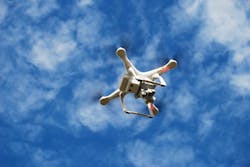According to a report published in January by ABI Research, consumer shipments of consumer unmanned aerial vehicles, more commonly referred to as drones, are expected to increase from 4.9 million in 2014 to an astounding 90 million during 2025. The increased use of UAVs by hobbyists and businesses alike have raised significant privacy concerns across the country and many state legislatures have already passed laws governing their use. Some have even expressed fears that terrorists could purchase drones and use them to deliver an explosive device or some type of deadly pathogen.
While there are already several drone detection systems on the market that leverage acoustics as a detection mechanism, many of them are vulnerable to various environmental factors that can render them useless under certain conditions. SpotterRF and Black Sage Technologies are looking to change that as they have rolled out a new counter-UAV system this week at ISC West, which they think will be a game-changer for the industry. The UAVX system leverages a combination of radar, artificial intelligence, and long-range video tracking technology to spot and track drones at distances ranging from 350-meters to as far as 700-meters away depending on the lighting conditions and various camera options that can be utilized by the end user.
According to SpotterRF CEO Logan Harris, Black Sage uses radar information gathered by SpotterRF’s compact surveillance radar units, such as position, direction and speed, and run it through their artificial intelligence software platform to teach it exactly what behaviors and characteristics are assigned to a particular target.
“That way they are able to teach their artificial intelligence software how to do automatic target recognition. They can say okay, that’s a person at 90 percent confidence or it’s an animal at 85 percent confidence level,” explained Harris. “The way the whole system works is the radar, first of all, gives wide area coverage. It’s able to pick up something like a DJI Phantom-sized target at 350-meters and then queue the camera onto the drone and that’s when we can switch in with the video tracker and get a tighter focus once the camera is in the vicinity of the target. At that point different alarms can be sent to the backend system and a proper response can follow based on what action the user is authorized to take.”
While end users have the option of adding communications jamming technology to the UAVX system, Harris said that most organizations outside of sensitive government or military installations cannot legally bring down or interfere with a drone in flight.
According to Harris, there are two main reasons why the UAVX is superior to some of the acoustic sensor-based drone detectors that are currently available on the market. First, Harris said that radar is much less susceptible to environmental conditions.
“Rain and snow basically render an acoustic sensor inoperable. During those periods when it’s raining or snowing, they basically have to be shut off because they generate too many false alarms,” said Harris. “With radar that’s not a problem, we can see through the rain and the snow. There’s also the issue of background noise. As snow and rain impact acoustics, another thing you have to take into account is in a noisier environment where you’ve got trucks or planes, that can provide background clutter that basically masks the signature of the drone you’re trying to detect.”
Secondly, Harris said that acoustics are not very good in pinpointing the location of a drone in the sky.
“Acoustics are not quite as accurate at knowing the exact position of where the target is or how many meters it is away,” he said. “With our system, the radar knows a pretty precise location in range and angle to that target and that allows us to do the automatic queuing of a camera onto the target for visual verification.”
Harris said that his company has been doing drone detection-type projects since their surveillance radar units hit the market several years back, however, the recent proliferation of UAVs has made it a much bigger security issue.
“It was bound to happen. It’s a new type of threat that existing systems haven’t really been built to address,” he added. “Air traffic control radar isn’t really going to pick up these little drones and there just happens to be a nice correlation between our radar system and these drone-sized targets.”
Harris believes the UAVX would be an ideal solution for securing large critical infrastructure sites as well as stadiums, utilities, government facilities, and even military-type applications.
“Anyone with $1,000 can get a drone that is quite capable of flying a kilometer with high-quality video surveillance and there is one thing I tell everyone I talk to, which is these high-security sites like power plants and so forth, they need the option to do active response, such as jamming or something else, where they can physically stop the drone from entering into these areas,” said Harris. “Right now, the laws are such that their hands are tied when it comes to what they can do against this threat. They need to have that capability and we need to change our laws so that in these types of cases, things can be done legally to stop drones.”


